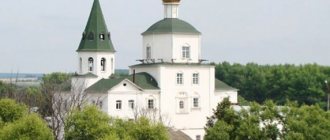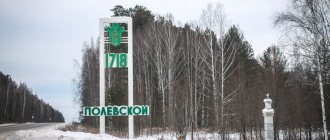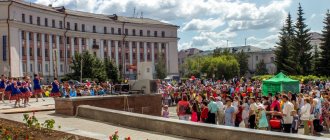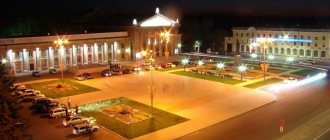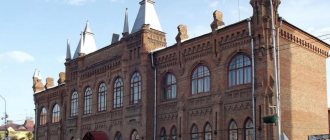Odintsovo is a typical town near Moscow, the western Castle of Moscow. On the map of Odintsovo from a satellite you can see that the Mozhaisk Highway stretches through the city. From the north-eastern border of the city to the Moscow Ring Road is only 4 km.
A major role in the formation of a settlement and the formation of a city over many centuries is played by its geographical location relative to transport routes and interchanges. In the middle of the 15th century. during the annexation of the Smolensk lands to the Moscow principality, the “important sovereign road” was laid precisely through the village, which at that time belonged to the boyar Odinets. On the map of Odintsovo with diagrams you can see the current location of the roads connecting the region with Moscow.
In the 19th century The railroad passed through the settlement, and the workers who serviced it settled. After clay deposits were found in the vicinity of the village, brick factories appeared on the site of modern Odintsovo.
In the Soviet 50s, several surrounding towns and villages were annexed to Odintsovo, and this settlement received city status. Several industrial enterprises were located on the territory of Odintsovo, most of them ended their existence in the 90s.
Looking at the map of Odintsovo by district, you can notice that the territory of the settlement is rich in forests and small reservoirs, the main of which are:
- Saminka River;
- Glazyninsky Pond;
- Lake Gubkino.
Residential neighborhoods have small ponds and lakes.
Map of Odintsovo with streets
The main transport artery of the city, as can be seen on the map of Odintsovo with streets, is Mozhaiskoye Highway. This is a very busy road along which both urban and transit transport moves. You can avoid entering the city by driving around it along the M-1 road, but there is a toll here, so most cars still drive through the city.
A map of Odintsovo with streets and houses allows you to see the main streets of the city:
- Union;
- Verkhne-Proletarskaya;
- Marshal Zhukov;
- Marshal Nadelina;
- Central;
- Govorova.
Podushkinskoe and Krasnogorskoe highways originate in the city. The city has 5 passenger internal bus routes and many minibuses. Buses run constantly to Moscow.
On the map of Odintsovo with houses, zooming in using the “+” icon, you can find the railway station building. It is located near Station Square in the dead-end part of Sovetskaya Street. Near the station, modern shopping malls and the Odintsovo Arbat were built not far from each other.
There are several other railway platforms in the city:
- Pionerskaya;
- Otradnoye;
- Trekhgorka;
- Bakovka.
Sometimes, especially during rush hours, moving from one city district to another by train is much easier than by car or bus.
City `s history
The history of the ancient Odintsovo land goes back to the distant past.
The guardians of the history of the region are numerous archaeological monuments located in almost every corner, their number reaches more than a hundred. The earliest are the ancient settlements of the beginning of our era; these include Barvikhinskoye, Lutsinskoye and Mozzhinskoye. During archaeological excavations in the Odintsovo region, clay weights, bone arrows, ceramic objects, remains of a mammoth skeleton and ancient jewelry were found. Of the existing cities in Odintsovo land, the most ancient is the city of Zvenigorod. It got its name from one of the cities of Kievan Rus. According to the chronicles, in the west of modern Ukraine there was the town of Zvenigorod Galichsky, and near Kyiv there was the town of Zvenigorod Kyiv. These cities ceased to exist by the middle of the 13th century as a result of the Mongol invasion, and even earlier their population fled from the raids of nomads and princely strife, gradually leaving for North-Eastern Rus', where in memory of the former cities they called new villages with familiar names. There is no exact date for the founding of the city of Zvenigorod, but archaeological research indicates that Zvenigorod existed in pre-Mongol times.
In written sources of the 14th century, other villages of the region begin to be mentioned. True, information about them is very scarce and is contained almost only in the spiritual letters of the Moscow princes of that time.
In the second half of the 14th century, despite the invasion of Tokhtamysh, who ravaged Zvenigorod in 1382, the region continued to develop. This is indirectly evidenced by the size of the Horde tribute collected by the Moscow princes from their possessions.
Many of the modern cities near Moscow arose from rural settlements. These include the current regional center of Odintsovo.
It got its name from the nickname of the boyar Grand Duke Dmitry Donskoy - Andrei Ivanovich Odinets, who lived in the second half of the 14th century and belonged to an old boyar family. The estate was in the hands of the Odintsov family until Andrei Ivanovich’s grandson, Fedosy, somehow angered Grand Duke Vasily the Dark and was forced to flee to Lithuania, where he died. Odintsovo was given into the possession of various persons, until at the end of the 16th century it became the estate of the Islenyevs, a branch of the famous family of boyars Velyaminov-Vorontsov.
In 1668, the sons of Stepan Islenyev, Danila and Ivan Stepanovich, bought Odintsovo as their patrimony, and five years later they sold it to the boyar Artamon Sergeevich Matveev, a prominent statesman of the era of Tsar Alexei Mikhailovich. Under him, a wooden church was built in Odintsovo and it turned into a village. By the end of the 17th century, there were already 22 peasant 18 bobyl households, where 81 people lived.
After the death of Tsar Alexei Mikhailovich, Matveev fell into disgrace and was exiled to Pustozersk, then to distant Mezen, and Odintsovo was included in the palace lands. Artamon Matveev returned from exile 10 years later, when young Peter I and his brother Ivan ascended the throne. A year later, in 1683, by royal decree, Odintsovo was returned to A.S. Matveev’s son, Andrei Artamonovich.
In 1704, Andrei Artamonovich built a wooden church in memory of his father, in the name of the holy martyr Artemon.
After the death of Andrei Artamonovich, his son Count Matvey Andreevich in 1735 mortgaged Odintsovo to the widow of Count Pavel Ivanovich Yaguzhinsky, Anna Gavrilovna, from whom it passed to her son Count Sergei Pavlovich Yaguzhinsky. The latter in 1760 sold the village to Count Andrei Mikhailovich Efimovsky, from whom it went to his son Pyotr Andreevich. According to data from 1786, there were 205 revision souls in Odintsovo. In 1800, Count Alexander Andreevich Zubov, the brother of Platon Zubov, the last favorite of Catherine II, became the owner of Odintsov.
In 1802, Zubov’s wife Elizaveta Vasilievna completed the construction of the stone church “In the Name of the Grebnevskaya Mother of God” in the style of Moscow classicism, which has survived to this day. Later, a bell tower more than 30 meters high was added to the church and two chapels were built. The parish of the church included, in addition to Odintsov, the nearby villages of Akishevo, Mamonovo and the village of Markovo.
Being on the Smolensk road, Odintsovo found itself in a zone of hostilities during the War of 1812. Retreating to Moscow, on the night of August 31 to September 1, 1812, Kutuzov’s troops stopped in neighboring Mamonov. A day later, the French entered the village. Napoleon's order to Joachim Murat, who then commanded the cavalry corps, about the corps' withdrawal from Odintsovo has been preserved. The war dealt Odintsov and the surrounding area a serious blow.
The Zubovs owned Odintsov throughout the first half of the 19th century, until 1853, when Count Alexander Nikolaevich Zubov sold his estate to Privy Councilor Prince B.V. Meshchersky. Odintsovo peasants were completely freed from serfdom only 20 years after the reform of 1861. At the end of the 60s of the 19th century, a joint-stock company was formed headed by Prince Meshchersky and Count Uvarov, which took upon itself the construction of the Moscow-Smolensk railway. Construction of the road proceeded quickly and ended in 1870, although it was only one track. The second path was completed in 1879. With the construction of the railway, the appearance of the area changed dramatically and the village of Odintsovo appeared near the railway station. The village remains aloof, closer to Moscow. Over the years, the village became the center of the local district, this was facilitated by the development of brick factories.
In 1891–1892, the poet Valery Bryusov lived at his dacha in Odintsovo. The popular artist Pavel Orlenev spent several summer seasons; A.P. Chekhov’s cousin, A.A. Dolzhenko, and the famous artist, author of the coat of arms of the USSR, I.I. Dubasov, lived permanently in Odintsovo.
Every summer, on the patronal feast day of Peter and Paul, a fair was held in the village of Odintsovo. Local peasants traded their handicrafts here. Residents of the neighboring village of Laikovo were famous for their master mechanics. They made castles, lanterns and mugs. In the village of Perkhushkovo, the tailoring industry was very developed. Akulovo peasants brought their wooden toys to the fair, sharpened checkers and chess pieces, and lotto balls. Merchants from Moscow also came to the fair with their goods.
The famous Soviet actress Alisa Koonen left us a wonderful description of the Odintsovo fair. In her book “Pages of Life” she writes: “The most vivid impression of my childhood was the fair in Odintsovo, at that time a large trading village. The local teacher was a friend of my mother, and we visited her every summer during the fair.”
October 1917 brought a lot of new things into Odintsov’s life; Bolshevik cells appeared. By 1917, up to 1,000 people lived in the village, and on July 3, 1918, the Odintsovo district was formed, uniting 29 villages located around Odintsovo. The first Odintsovo council included railway workshop workers and party members: A. Samarin, A. Rodionov, A. Stolpakov, S. Makovsky and others.
Since 1920, an elementary school for 50 students operated in the village, located near the Mozhaisk road in a wooden barracks-type house. The village had two schools with 200 students each. In 1934, a seven-year school opened in the village of Akishevo, and four years later the same one appeared in the village. The village library began operating in 1930. At the beginning of 1939, more than 12 thousand people lived in the village of Odintsovo, and it was transformed into a workers’ village. The construction of urban-type houses began here. However, the outbreak of the Great Patriotic War did not provide an opportunity for further development of the village.
At the beginning of the war, one of the schools housed field military hospital No. 174, which received wounded soldiers. Odintsovo became the near rear of units of the 3rd and 33rd armies of the Western Front during the Battle of Moscow. The Akishev school was occupied by the headquarters of one of the regiments of the 21st Moscow militia division. The militia, together with Odintsovo residents, built a defense line in the Perkhushkov area.
Local enterprises switched to producing military products. The brick factory mastered the production of anti-personnel and anti-tank mines. The household chemicals plant produced special protective camouflage paints, and the furniture plant produced boxes for shells and cartridges.
Immediately after the war, the transition of the economy to peaceful lines began. In November 1947, a Metal Structures Plant was created on the basis of mobile repair and mechanical workshops. Back in 1943, Brick Factory No. 2 mastered the production of refractory bricks, and later refractory shaped products, becoming known as the “Vnukovo Refractory Products Plant.” The construction industry in the post-war years became one of the main industries in Odintsovo. Having healed its wounds, Odintsovo grew and developed. By 1957, 20.3 thousand people lived in the village of Odintsovo. On July 17, 1957, it was transformed into a city with the inclusion of the villages of Krasnaya Gorka, Verkhnee and Nizhneye Otradnoe, Zheleznodorozhny and the village of Yaskino. In 1965, a decision was made to expand the city’s borders: it included the village of Odintsovo and a number of neighboring towns and villages. According to the population census, in 1989, 125 thousand people lived here, and 270 thousand in the Odintsovo district.
The functions of the city of Odintsovo became more complex and expanded; it became the administrative, cultural and economic center of a large region of the Moscow region. The city has several industrial enterprises producing refractories, white and colored enamel tableware, household oil paints, rubber products and veneers for furniture.
Map of Odintsovo with houses
The city of Odintsovo occupies a relatively small area, only 20 km2. But about 150 thousand people live in it. Using a map of Odintsovo with house numbers, you can see its division into microdistricts, there are 15 in total. Residential areas are assigned numbers, and on the three outskirts of the city there are the western, southern and eastern industrial zones.
Microdistricts No. 1 and No. 1A are considered central. They are located in the area of Sadovaya, Molodezhnaya, Zhukova streets. Here are:
- Administration;
- Central square;
- Stadium;
- Ice Palace;
- Museum;
- Restaurant “Food and Only”;
- Banks;
- Pension Fund;
- Schools and kindergartens.
There is active construction in the city, buildings and residential buildings from the Soviet period are being demolished and modern housing complexes are being built. Therefore, the sight of unfinished high-rise buildings is a normal occurrence in Odintsovo.
Perhaps the construction of the residential microdistrict Kutuzovsky, which can be found on a detailed map of Odintsovo, can be called completed. There are all the necessary infrastructure facilities here, which cannot be said about areas where construction is moving at full speed.
The dream of residents of the city and region is the village of Rodniki, a cottage community of elite 2- and 3-story houses, which can be seen on Yandex maps of Odintsovo next to the Barvikha Forest. Essentially, Rodniki is a city within a city, where there is everything that residents need for a comfortable stay: good roads, shops, security with 24-hour video surveillance and much more.
Where is the city of Odintsovo?
Odintsovo is the administrative center of the Odintsovo urban district of the Moscow region and the western suburb of Moscow.
The city is divided into 15 microdistricts. The approximate population is 140 thousand people, the total area of the territory is 19 square kilometers. The climate in the city is temperate continental with humid, warm summers and mild winters. Due to high humidity, the feeling of cold intensifies in winter. The annual precipitation rate is 650 mm.
Odintsovo is located in the same time zone as Moscow, the offset relative to Coordinated Universal Time (UTC) is +3.
Economy and industry Odintsovo
For more than half a century, Odintsovo has been the main enterprise - most of the townspeople work here. The company is in charge of such large reconstruction and construction projects as the Moscow Metro, Krylatskoye, Strogino, and the main squares of the capital.
The second largest, whose products can be found in all cities of the country.
Another wonderful enterprise is the confectionery factory, which produces the well-known Korkunov candies. Salaries at the leading enterprises of Odintsovo are high, therefore, residents tend to work at their “native” factories, rather than leaving the city in search of work.
Odintsovo Airport
The city of Odintsovo does not have its own airport. The nearest airfield is Vnukovo, which is located in Moscow. The distance from the city to the airport is 10 km. Vnukovo is an international airport that has the status of a federal facility. It is one of the four main airports in Moscow and the Moscow region. It works every day around the clock. It has the third level of coordination according to the IATA classification.
The airport serves aircraft of major Russian and foreign airlines: Azur Air, Hong Kong Airlines, Privilege Style, Turkish Airlines, Aeroflot, iFly. Popular destinations of regular and charter flights: London, St. Petersburg, Dubai, Hong Kong, Rostov-on-Don. The annual passenger traffic is more than 21 million people.
Automobile highways
The following roads pass through Odintsovo:
- A100 Mozhaiskoe Highway (46K-1011) is a public road that has the status of an object of regional importance. The route runs from Moscow to Kubinka, Odintsovo, Mozhaisk, Borodino. The length of the road is 56 km.
- MKAD - Odintsovo borders on the Moscow Ring Road, the length of which is 109 km. The distance to the Moscow Ring Road is 4 km. The road surface of the route is asphalt concrete.
- E30 is a European route that starts in Ireland and passes through Germany, Great Britain, Russia, Poland, and the Netherlands. The length of the highway is 5,800 km.
